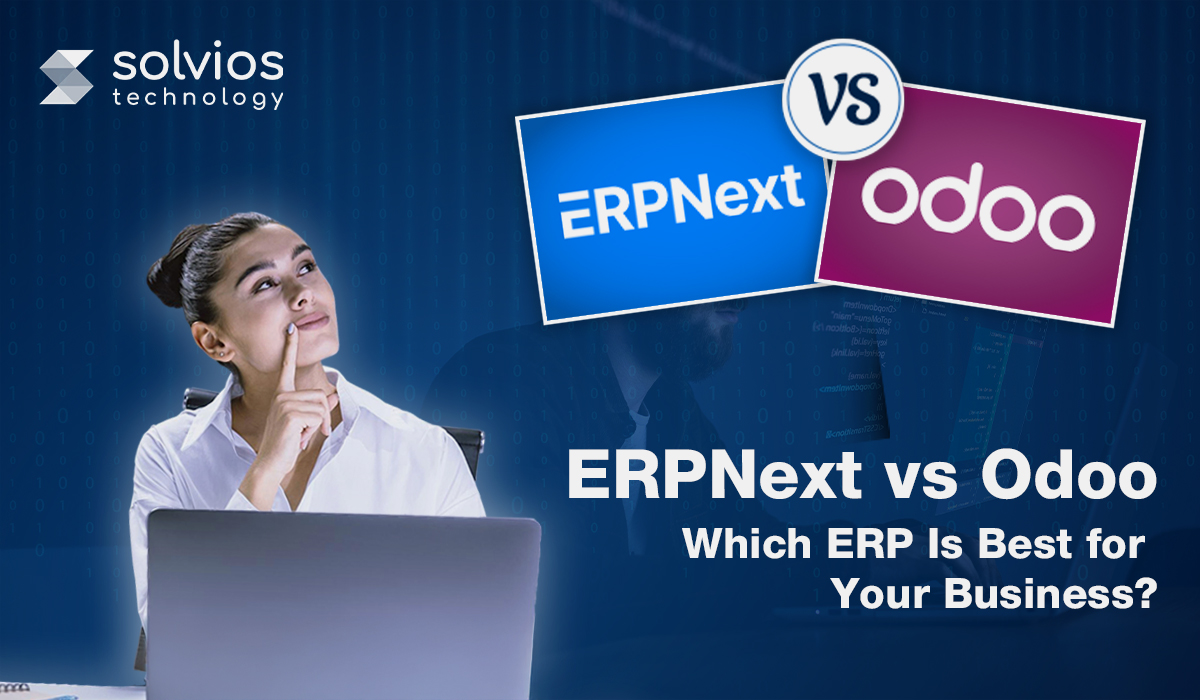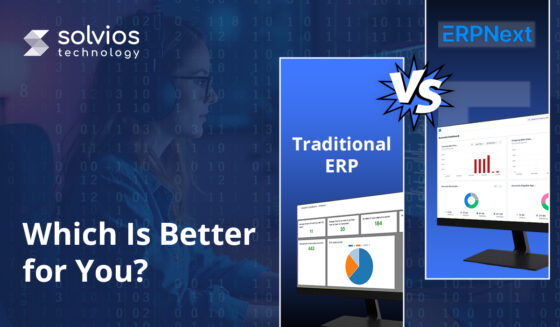
Introduction
Every business eventually switches from Excel and spreadsheets to its new best friend, an ERP system.
ERP software, or Enterprise Resource Planning software, is a great tool used by organizations to manage and control their operations within a structured framework. It automates business processes, improves productivity, and gives better control over operations.
Interestingly, when it comes down to it, the majority of organizations streamline their options to ERPNext and Odoo. These open-source ERP solutions give an edge to your operations, adding to their efficiency and reducing the core workload.
If you ask us, both are great options, and you can’t go wrong with either. But since you can’t integrate both, let’s have a detailed comparison of the two ERP suites. Continue reading as we learn more about the difference between ERPNext vs. Odoo in the following sections to aid your business in making informed decisions.
Overview of ERPNext and Odoo
ERPNext
ERPNext is an agile, open-source Enterprise Resource Planning (ERP) solution that optimizes and automates different aspects of your operations. The premier ERP is designed for small to medium enterprises and offers three core USPs, namely:
- Open Source and Agility
- Cost-Effectiveness and Accessibility
- Comprehensive Functionality
Odoo
Odoo ERP is a comprehensive and highly versatile business management suite renowned for its adaptability and holistic approach to enterprise resource planning. One key advantage of Odoo ERP is that it offers both enterprise and open-source (completely free) plans.
Odoo ERP is a comprehensive and versatile business management suite for scalability and automated features. It stands out as an ERP offering open-source (totally free) and enterprise options.
Here are the three leading USPs of Odoo as an ERP:
- All-in-One Platform with Extensive Modules
- Global Reach with 12 million Happy Users
- Open-Source Community and Customization Capabilities
Now that we have an idea of the core differences between the two ERPs, let’s learn more about ERPNext vs Odoo in the following sections.
Key Features of ERPNext Vs. Odoo: What Sets Them Apart?
Licensing and Cost Structure
Regarding cost structure and licensing, both ERPNext and Odoo offer unique models to their users. Each model caters to different business models and growth strategies.
ERPNext
Thanks to its open-source nature, ERPNext is available free of charge to everyone and does not incur licensing fees. The platform’s cost-effectiveness makes it ideal for budget-conscious businesses, whereas its open-source flexibility gives scope for customization.
However, while the platform is free, there are some costs involved in its customization, namely:
- Hosting (cloud or on-premise)
- Custom development and module configuration
- Ongoing support and maintenance
Odoo
Odoo, on the contrary, offers a dual-licensing model for its users. New users can start with a free model and upgrade to paid options as the scale of their needs. Here’s a detailed insight into the different models offered by Odoo:
- Community Edition – Free for all. Offers limited features but lacks official support for users.
- Enterprise Edition – It’s a commercially licensed model offering technical support and advanced user features.
The subscription price also depends on the number of users and the type of modules they use. It’s an excellent option for enterprises that prefer premium features and structured upgrades with subscription-based pricing.
Customization and Flexibility
Customization and flexibility are the keys to a reliable ERP. Businesses want to invest in an ERP that allows them to customize the platform, enabling simpler operations according to their unique requirements.
ERPNext
- ERPNext is built on the Frappe Framework, making it an excellent option for users with moderate coding knowledge.
- It suits businesses with unique workflows that want to conveniently customize features.
Odoo
- Odoo, on the other hand, is built on Python, allowing for a higher level of customization compared to ERPNext. Users can customize the platform using multiple third-party apps.
- Customization of the Odoo platform often requires technical expertise. Organizations need to hire experts for such inputs.
Features and Functionality
Features and functionality are another unique aspect of an ERP. No organization would want to invest in a system that doesn’t offer them the required features or functionality.
ERPNext
ERPNext implementations offers a comprehensive list of features and modules for small and mid-sized businesses. The exhaustive list of features includes:
- Manufacturing
- Accounting
- CRM
- HR
- Project Management
Odoo
Odoo, on the contrary, is a much more expansive ERP platform that caters to businesses of all sizes. It offers a wide range of modules, including:
- Sales Inventory
- HR
- Marketing
- eCommerce
- Among other options.
Scalability and Performance
Scalability and performance are the two crucial factors in deciding on an ERP. No business would want to integrate an ERP lacking either feature. Let’s understand more about it with this Odoo ERP vs ERPNext distinction.
ERPNext
ERPNext is the ideal platform for businesses with moderate data requirements, making it an effective ERP solution for growing companies. However, the ERP might deliver limited performance for highly complex operations.
Odoo
Odoo, on the contrary, caters to businesses with extensive data sets. It is the perfect fit for companies with a large user base, loads of data, and multiple locations. Odoo is the ideal ERP for a complex workflow.
User Interface and Experience
The UI/UX adds to the overall experience of any software or platform. The easier the platform, the higher the number of users who sign up for it.
ERPNext
ERPNext is a welcoming platform for businesses that want a minimal learning curve. The platform’s UI/UX elements make it easy for users to onboard and get started.
Odoo
Odoo welcomes users with a wide range of functionalities designed to streamline different aspects of their operations. However, the modern interface makes the learning journey challenging.
Integration and Extensibility
Integration and extensibility are other contributing factors to an ERP. Businesses want to integrate systems that facilitate operations.
ERPNext
ERPNext enables connectivity with various third-party apps, making it an ideal choice for enterprises that require moderate extensibility. However, it supports only a limited number of native mobile apps, necessitating third-party solutions for a flawless mobile experience.
Odoo
Odoo is highly expandable and excels at integrating with a diverse set of third-party apps and services. It supports Android, iOS, web, and desktop platforms, making it more adaptable to mobile and cross-platform use.
Community and Support
The type of community and support an ERP offers can significantly determine your purchase decision. Access to real-time support and an established community helps reduce the time it takes for business owners to overcome hurdles and resume operations.
ERPNext
The ERPNext ecosystem is supported by a small but committed open-source community. Frappe Technologies and a network of approved partners provide official support, assuring dependable service for those needing expert assistance.
Odoo
Odoo welcomes users with a global community and an ecosystem of developers, consultants, and official support channels. Access to talents in real time simplifies deployment and troubleshooting for users.
Deployment Options
The means of deployment is also a determining factor for an ERP. Since the means of deployment contribute to the overall costs, it’s essential to understand the options beforehand.
ERPNext
ERPNext is offered both in the cloud and on-premises. While the cloud version is simple to set up, the on-premise version may need technical knowledge for effective implementation and maintenance.
Odoo
Odoo also offers a range of deployment options, including cloud, on-premise, and hybrid models, with tools such as Odoo. It facilitates hosting and upgrades, particularly for companies without an in-house technical team.
Still confused with ERP Next vs Odoo? Let’s learn more about the two platforms with a table.
| ERPNext | Pros | Cons |
| Cost-effective | Limited scalability for large enterprises | |
| User-friendly | Fewer third-party integrations. | |
| Suitable for SMEs |
| Odoo | Pros | Cons |
| Highly scalable | Complex pricing structure | |
| Extensive module offerings | May require technical expertise for customization | |
| Strong community support |
ERPNext Vs. Odoo: When to Choose the Platforms?
When to Choose ERPNext Over Odoo?
- You need a simple, cost-effective ERP for SMEs.
- Your business is in manufacturing, healthcare, or education.
- You prefer out-of-the-box functionality over heavy customization.
When to Choose Odoo Over ERPNext?
- You run an eCommerce/retail business (needs POS, Shopify).
- You require deep customization & enterprise scalability.
- You have in-house developers to manage complexity.
Final Verdict: Which One Should You Pick?
Choosing the right ERP for your operations is a crucial decision, as it significantly impacts the future of your business. While ERPNext and Odoo ERP are great options for any business, organizations should prefer ERPNext if:
- They’re SMEs
- Into manufacturing
- Want a simple ERP
On the contrary, you might choose Odoo if:
- You’re into eCommerce
- Enterprise-level operations
- Looking for flexibility and customization
Still unsure? Reach out to our experts for a ‘free consultation’ today!
Ready to boost your business with the right ERP? Our experts will help you choose and optimize ERPNext or Odoo for success.
Book a free consultation now!Tags
Related Blog
Want to get started with App Development?
These applications are acquiring enormous prevalence by offering hands-on enterprise mobility solutions for organizations around the globe.
Start A Conversation
















